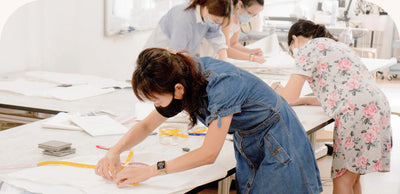
6 Common Sewing Questions that NOT-SO-BEGINNER Sewists Ask
Make sure to also check out the other post that covers the most common sewing questions that beginners should also know!
Have you ever wondered why we need interfacing, or how come there are so many stitch lengths on the sewing machine? We cover the questions that you might have found yourself wondering while sewing and need the answers to. Need some face-to-face help? Our classes can cover the basics for beginners, all the way to intermediate.
1. Why do my threads keep bunching up?
Bunched up threads is a common problem but how easy it is to fix depends on one thing: does the bunching only happen at the start of your threading?
If Yes: Your threads are nesting. This is easier to solve. Fix this with Solution A.
If No, it's happening all the time: Fix this with the various solutions in B.
Bunching happens most likely due to tension issues - the top and bottom threads are experiencing different amounts of tension. They are therefore unable to align at the same pace/stitch. However, this is often not because of the tension dial, but because of some tension issues along the spool or bobbin!
Solution A:
- Before you start sewing, make sure you pull your top and bobbin threads underneath and behind the footer.
- Hold onto the thread ends firmly (don't tug!) when you are doing your start and reverse stitches in the beginning. This prevents them from getting caught in your stitching.
- Start sewing about 3mm inside from the edge of the cloth. Don't start right at the edge, especially for thinner fabrics! The needle will tend to cause the cloth to get pushed and sink under.
- If you have the patience for it, you can even start your stitching on a scrap cloth placed just before your actual cloth to kickstart your stitching. This will get all the thread nesting issues out of the way!
Solution B:
There are various causes to why your threads might be bunching up all the time. Let's dive right in to the issues and how to solve each of them!
a. Threading
Check your machine and bobbin threading (and the manual if necessary).
- Is your bobbin thread wounded too loosely around the bobbin?
- Did you skip any tension discs in doing your top or bobbin threading?
- Is your bobbin in the correct direction and is the bobbin thread engaged correctly?
- Make sure all the threading is correct, rethread to make sure! You may refer to the diagram below - your thread has to generally look like a "P", as shown in red.

Some sewing machines might have this diagram on the cover of the bobbin drum.
b. Needle
Is your needle the correct size for the thread and fabric, or is it too blunt? Try changing to a new needle. Thinner fabrics call for thinner needles and thicker fabrics call for thicker needles! Not sure of which needle to use? jump right to the next question.
c. Fabric
Does your machine work on other fabrics? Or just one type? If you are unsure, test with a regular weight fabric like calico or muslin to be sure.
d. Bobbin Type
Ideally, you should use the bobbin that comes with your machine. Industrial and domestic bobbin sizes are different with the former being flatter. Plastic or metal domestic bobbins may differ in their performance on your machine.
e. Thread
Good quality thread helps make your stitches look better. Refer to this post on thread quality and recommendations.
f. Clean Bobbin area
Make sure the bobbin area under your machine is not full of lint and dust. We highly recommend to do this carefully as it is usually not recommended to unscrew your machine unless absolutely necessary. You may take a video of what it looks like whilst you do it in case you forget to screw it back properly.
g. Call for servicing
If all else fails, please call your sewing machine vendor or look for your closest sewing machine repair shop to save your machine. We have some suggestions below, click on the names to find out their details!
Independent Machine Repair Shops:
- Freddy Sewing Machine Service
- Poh Soon Industrial Sewing Machine
- Guan Lee Long Sewing Machine
- Singer Repair & Services
Distributor/Service Centers:
- Brother Service Center
- Juki/Janome Service Center (You may contact stitch4you for these brands)
- Singer/Pfaff/Viking Service Center (You may contact for servicing on Singer and Viking only)
2. Which sewing machine needle should be used for which fabrics?
For your easy reference, below is a simple guide for universal needles on woven fabrics. If you are using knit fabrics like lycra or jersey, we do recommend using stretch needles instead! Stretch needles will not cause holes in your fabric with their ball-point tip.

3. Do I really need to interface? What types of interfacing should I use?
Interfacing is a type of fabric used in specific areas of a garment or on items like bags to help give structure. It shapes and stabilises these areas/items. They are either sewn or fused in between the fabric layers and are not meant to be seen from the outside. Interfacing most commonly comes in white. You can check out shops like Lye Nai Shiong, Sing Mui Heng or Spotlight for a good range of thicknesses!
As a general guide, try not to use an interfacing that’s thicker than your fabric. On garments, you generally only need light to medium weight interfacing. The more structured you want an area to “stand”, the thicker the interfacing to use (but still not thicker than your fabrics). A good example is collars or cuffs - these parts will require a thicker interfacing as opposed to the interfacing needed when stitching zippers.
Interfacing construction types:
- Woven Interfacing: Feels more like fabric with more drape and hence it is commonly preferred for garments.
- Non-woven Interfacing: Feels more like paper and can be used in any direction, however it gives a stiffer look when fused with fabric.
- Knit Interfacing: Can stretch with the fabric. A very common choice for garments with any form of stretch and can also be used with woven fabrics. This is because it will stay in place upon fusing and can still maintain a good deal of drape.
Interfacing attachment types:
- Fusible Interfacing: Often used in garments in areas like collars, cuffs, waistbands, plackets and lapels. Sometimes it is even used to help reinforce certain areas or help mend some overly snipped areas on fabrics.

The glue (often shiny) side down of your fusible interfacing.
To apply fusible interfacing:
- First pre-shrink your fabric with heat and steam to make sure it's "shrunk" before you apply your fabric on. You should test the interfacing beforehand to make sure it's the stiffness you want.
- Place the glue (often shiny) side down on the wrong side of your fabric. Place a cotton fabric over it and then press with an iron (High heat for natural fibres, low heat for synthetic).
- Hold for about 5 to 8 seconds, depending on how thick the interfacing is. Gentle gliding with light steam may be required if bubbling happens.

Non-fusible Interfacing can be purchased here.
- Non-fusible Interfacing: This interfacing is only stitched on the edges to the cloth and hence will give the garment/item a softer, less "stiff" drape. Therefore non-fusible interfacing is often used on fabrics that may be heat sensitive, textured or pleated as it won't flatten such fabrics. As it needs to be stitched on the fabrics beforehand, it does take more time! The advantage is that it can be easily removed.
4. What stitch length should I use?
Stitch length refers to the size of the stitches in millimetres. 2.5 = 2.5mm and the length depends on 2 main factors:
- Purpose of your stitching
- Thickness of your fabric (the thicker the fabric, the wider the stitches).
- If you are using this for joining 2 layers of fabrics together, as part of building your garment: You may use stitch lengths 2.4 to 3.0.
- If it will be seen as part of your top-stitching: You can go with slightly larger stitches in the range of 2.4 to 3.5.
- If you are using this as a temporary basting stitch, that you expect to be easily removed later on: Use 5.0 or the largest stitch you have. Same goes for gathering, where you expect to pull on your stitches later on.
- If you are using very light or fine fabrics: Stitch lengths 2.0 to 2.4 would be ideal.
- If you are using medium weight fabrics: Stitch lengths 2.4 to 2.8.
- If you are using thicker fabrics: Stitch lengths 3.0 to 4.0 as the thickness of the fabrics will cause the stitches to sink deeper and become smaller and denser.
5. Which tension on the tension dial should I use?
Good stitch tension on any fabric is seen when the top and bottom threads form even stitches with no looseness or tightness in the stitching or pulling in the fabric. Run your fingers over the top and bottom stitches - they should feel smooth. As a good practice, always check the tension on a scrap piece of your actual cloth first as different fabric thicknesses affect tension.
Assuming all your threading is correct, and any issues in tension are addressed in question 1, the general rule of thumb is this: thinner fabrics use lower tension and thicker fabrics use higher tension.
The middle setting on your tension dial (between 4 to 5 if your tension range is 0 - 9) is the go-to tension for most projects. When changing the tension, try to adjust one number up or down at each time and test first.
Look at the examples below for what low, high and correct tension settings looks like:


The tension affects the quality of your stitches.
6. Do I always need to make a toile/sample first?
It depends on:
- Has this fit or design ever been tested before?
- Is the fabric you are using very similar in stretch or thickness?
If your answers are Yes to both of the above, then making a toile/sample first is not necessary. If the answers to any of them are No, we definitely recommend doing a toile/sample first. This is to save time unpicking and doing alterations on your dear fabric later on. You may pick a cheaper alternative fabric and work on a single layer to get the fitting and design right first.
With this, we hope you have a clearer picture when sewing, and are able to overcome the challenges you face when you’re knee deep in that sewing project! If you have just been researching before starting on this new hobby, the sewing journey will help you understand where to start sewing and how to move forward.

